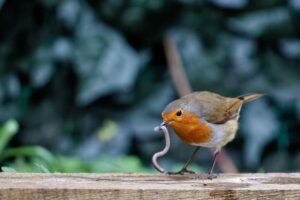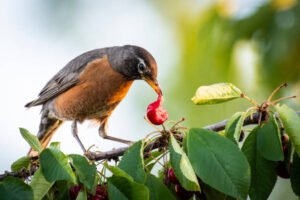
Examining robins’ eating habits reveals an intriguing trip through a varied cuisine that reflects their flexible and omnivorous disposition. Known for their characteristic red breasts, these birds have a broad culinary repertoire and a taste for various foods.
A staple of the robin’s diet, earthworms are skilfully picked off the ground, especially after a rainstorm when these writhing treats become visible. Robins are drawn to berries throughout the warmer months because of their vivid colors and delicious flavors, ranging from rich blueberries to luscious strawberries. The robin’s culinary explorations also encompass insects and other invertebrates, with a menu that includes spiders, beetles, grasshoppers, and caterpillars.
Fruits become more prominent as the seasons change; apples, cherries, and grapes become tasty and nutritious additions to their diet. Darkling beetle larvae, or mealworms, add even more protein to their food, making it much more enjoyable. This study, “What do Robins Like to Eat” focuses on earthworms, berries, insects and invertebrates, fruit, and mealworms, ingredients that satisfy robins’ dietary requirements while also bringing delight to birdwatchers who wish to comprehend and draw these endearing birds to their habitat.
Robins’ Culinary Odyssey: A Gastronomic Exploration
| Aspect | Details |
|---|---|
| Introduction | Robins, famed for their red breasts, embark on a diverse culinary journey, savoring earthworms, berries, insects, fruits, and mealworms. Beyond mere preferences, these choices unveil ecological roles within their habitat. |
| Earthworms | Crucial to robins, earthworms are deftly captured post-rain, highlighting adaptation and a delicate balance with invertebrates. |
| Berries | A significant diet component, berries not only delight robins’ taste buds but aid in seed dispersal, showcasing a mutualistic connection between their dietary choices and ecosystem dynamics. |
| Insects and Invertebrates | Versatile foragers, robins target spiders, beetles, and more, contributing to pest control and ecosystem balance. |
| Fruits | Robins’ fruit preferences extend beyond taste, promoting seed transmission and a symbiotic link with plant life. |
| Mealworms | Adding a protein-rich dimension, mealworms exhibit adaptability and hint at human-influenced cohabitation. |
| Conclusion | Robins’ culinary diversity reflects adaptability and ecological significance, offering insights into ecosystem dynamics. |
| FAQs | Addressing common queries about robin diets and strategies to attract them, enhancing understanding of avian gastronomy. |
Lets discuss about the Robin’s 5 favourite foods one by one in the details:
Earthworms
Earthworms are essential to robins’ diet and a mainstay in their culinary selections. The robin is well known for its superb earthworm-hunting abilities; it carefully retrieves these squirmy invertebrates from the ground. In this pursuit, the birds are most busy, especially after a downpour that brings the earthworms closer to the surface. Earthworms, high in protein and nutrients, are essential to the health and well-being of robins.
Not only is the relationship transactional between robins and earthworms, but it’s also a fantastic example of avian adaptation. The bird can find and catch earthworms efficiently thanks to its vision and foraging skills. This feeding choice illustrates the complex ecological balance between robins and the invertebrates that live in the soil and the adaptability of these birds. Knowing how important earthworms are to robins’ food helps us better understand their dietary needs and emphasizes how these birds of prey are linked to the environments in which they live.
Berries
Delicious and colorful berries make up a large part of a robin’s diet. These endearing birds, distinguished by their distinctive red breasts, clearly enjoy a wide variety of berries, a significant amount of their diet. Robins are drawn to various foods throughout the warmer months, from the rich juiciness of blueberries to the sweet succulence of strawberries. Being expert foragers, robins dart between bushes and trees for these tempting fruits. Eating berries meets their nutritional needs for vitamins and antioxidants and satisfies their palates. This dietary decision aligns with the berries’ seasonal availability and highlights how robins can be flexible in their food source selection.
Eaters of berries, robins have an ecological function for eating berries in addition to their culinary one. Because they consume so many berries, robins aid in spreading seeds and regaining various plant species. The mutualistic connection between berries and robins serves as a reminder of the interdependence of all things in nature, as bird diet decisions impact the larger ecosystem. Examining the robin’s fondness for berries reveals a taste in food and an intriguing segment in the complex dance of the natural world.
Insects and Invertebrates
A vibrant and high-protein aspect of the robin’s diet consists of insects and other invertebrates. Renowned for their versatility, these birds strongly prefer a wide range of small animals that live in the undergrowth. Robins are attracted to and hungry for insects and invertebrates, including spiders, beetles, grasshoppers, and caterpillars. Robins are excellent foragers; they use their keen vision and quick reflexes to seize these little morsels. The birds benefit from this nutritional diversity in two ways: it helps keep pests out of their homes and gives them access to vital nutrients like protein. Robins’ ecological relevance is demonstrated by their ingestion of insects and other invertebrates, which helps keep local insect populations in balance.

The availability of these tiny animals varies with the seasons, highlighting how adaptable robins are. Their capacity to change their diet to include invertebrates and insects indicates a flexible foraging strategy that guarantees they will always have access to the required nutrients. Comprehending the function of these organisms in the robin’s diet reveals a nuanced interaction between bird predators and the smaller members of the understory, emphasizing the delicate equilibrium within ecosystems that support robins.
Fruits
One delicious and nourishing item in the robin’s culinary repertoire is fruit. Distinguished by their characteristic red breasts, these bird foragers exhibit a sophisticated taste for a wide range of fruits, with a fresh crop of mouthwatering choices appearing every season. Among the fruits that draw robins’ attention are apples, cherries, and grapes; these offer a tasty and delicious treat and vital vitamins and nutrients. Fruit consumption by robins is an example of their adaptation, showing a gastronomic flexibility that corresponds with the varying seasons. Fruit intake is highest in the warmer months when these luscious options are abundant. Not only does robin fruit-gathering satisfy their palates, but it also improves the environment.
Beyond food consumption per se, Robin’s use of fruit has ecological implications. Robins help spread seeds by eating fruits, which promotes the regrowth of many plant species. The mutualistic connection between robins and plants that bear fruit highlights how intertwined ecosystems are. Examining the place of fruit in the robin’s diet exposes the bird’s taste for certain foods and the mutualistic relationship that foragers have with the plants in their environments.
Mealworms
Mealworms give robins’ food choices a rich, protein-filled, and alluring depth. Robins are drawn to these darkling beetle larvae, which adds to their food variety. Mealworms are a great source of protein that robins eat, which helps them meet their overall nutritional demands. Because of their keen vision and quick movements, robins are skilled at searching for mealworms. Robins demonstrate their versatility by including mealworms in their diet, regardless of whether they are in their natural habitat or are drawn to bird feeders filled with these tiny larvae. This is a critical dietary decision during specific periods of the year when other food sources may be unavailable.

Mealworms serve more purposes in the robin’s diet than just food. Mealworms are a standard tool gardeners use to draw robins to their plots, giving these delightful birds another food source. The benefit that both robins and mealworms receive from one other highlights the versatility of these birds and the part that human intervention may play in promoting peaceful cohabitation between enthusiasts and nature. Comprehending the function of mealworms in the robin’s diet offers a valuable understanding of the diverse tactics these birds utilize to satisfy their dietary requirements in various settings.
Conclusion
The eating habits of robins present an intriguing story about their adaptability and omnivorous nature. From the carefully harvested earthworms following a downpour to the colorful variety of berries enjoyed during the summer, robins have a culinary adaptability that corresponds with the passing of the seasons. Their ability to forage includes insects, invertebrates, and mealworms, highlighting their ecological function in preserving the balance of local ecosystems and their nutritional versatility.
Fruits, such as apples, cherries, and grapes, highlight the symbiotic relationship between robins and plant life in their habitats by serving as more than a tasty treat. They also aid in seed transmission. By delving into “What do Robins Like to Eat: 5 Favourite Foods,” we can better understand the intricate web of life and the interrelated dance of nature, in addition to earning a list of preferences.
FAQs
Q: What constitutes a robin’s main diet?
A: Earthworms, berries, insects, invertebrates, fruit, and mealworms are among the many foods that robins eat daily. These omnivorous birds demonstrate adaptation by modifying their food according to geographic location and seasonal availability.
Q: Why do robins like to eat earthworms?
A: Because earthworms are abundant in protein and have great nutritional value, they are a preferred diet of robins. When it rains, the earthworms become closer to the surface, making it easier for robins to retrieve them from the ground.
Q: How does the food of robins benefit ecosystems?
A: Due to their food, robins are essential to ecosystems. They help manage pests by eating insects and other invertebrates, and they promote the regeneration of plant species by helping to disperse seeds through their fruit intake.
Q: Which berries are preferred by robins, and why do they consume them?
A: Berries are eaten by robins because of their pleasant taste and nutritional value. Depending on the season, they favor various berries, such as raspberries, blackberries, blueberries, and strawberries.
Q: How might mealworms be used to attract robins, and what part do they play in their diet?
A: Mealworms give robins an additional source of protein in their diet. Offering mealworms in bird feeders is a common way for avian lovers to draw robins to their gardens. This serves as an extra food source for the birds, especially when natural food sources are limited.





